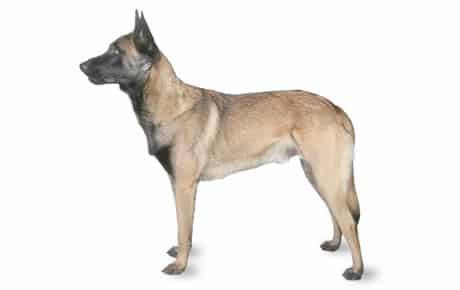The Malinois is a medium-to-large breed of dog, sometimes classified as a variety of the Belgian Shepherd dog rather than as a separate breed. The name "Malinois" is derived from Malines, the French name for the breed's Flemish city of origin, Mechelen.

The breed is used as a working dog for tasks including the detection of odors such as explosives, accelerants, and narcotics; tracking humans for suspect apprehension in police work; and search and rescue missions. The U.S. Secret Service uses Belgian Malinois to guard the grounds of the White House.
Jump to:
Belgian Malinois Facts: History
The Belgian Malinois is one of four varieties of Belgian Sheepdogs which were developed in Belgium in the late 1800s. The four varieties are the Malinois (fawn-mahogany, short coat with black mask), Tervuren (fawn-mahogany, long coat with black mask), the Laekenois (fawn, rough coat), and the Groenendael (black, long coat). The American Kennel Club (AKC) recognizes all but the Laekenois as separate breeds in the U.S., while the United Kennel Club recognizes all four types as one.
Belgian Malinois Facts: Temperament
This is an outstanding working dog who is confident and protective in any situation. He's affectionate with family members but reserved toward strangers until he takes their measure. The watchdog abilities of the Malinois are excellent. He protects his people and property with only as much force as is required. Shyness and aggression are never appropriate in this breed.
That said, temperament doesn't just happen. It's affected by a number of factors, including heredity, training, and socialization. Puppies with nice temperaments are curious and playful, willing to approach people and be held by them. Choose the middle-of-the-road puppy, not the one who's beating up his littermates or the one who's hiding in the corner. Always meet at least one of the parents. Usually, the mother is the one who's available to ensure that they have nice temperaments that you're comfortable with. Meeting siblings or other relatives of the parents is also helpful for evaluating what a puppy will be like when he grows up.
Like every dog, Malinois need early socialization exposure to many different people, sights, sounds, and experiences when they're young. Socialization helps ensure that your Malinois puppy grows up to be a well-rounded dog. Enrolling him in a puppy kindergarten class is a great start. Inviting visitors over regularly and taking him to busy parks, stores that allow dogs, and on leisurely strolls to meet neighbors will also help him polish his social skills.
Belgian Malinois Facts: Health
The Belgian Malinois has some concerning health problems:
- Hip Dysplasia: This is a heritable condition in which the thighbone doesn't fit snugly into the hip joint. Some dogs show pain and lameness on one or both rear legs, but you may not notice any signs of discomfort in a dog with hip dysplasia. As the dog ages, arthritis can develop. X-ray screening for hip dysplasia is done by the Orthopedic Foundation for Animals or the University of Pennsylvania Hip Improvement Program (PennHIP). Dogs with hip dysplasia should not be bred. If you're buying a puppy, ask the breeder for proof that the parents have been tested for hip dysplasia and are free of problems. Hip dysplasia is hereditary, but it can also be triggered by environmental factors, such as rapid growth from a high-calorie diet or injuries incurred from jumping or falling on slick floors.
- Progressive Retinal Atrophy (PRA): This is a degenerative eye disorder that eventually causes blindness from the loss of photoreceptors at the back of the eye. PRA is detectable years before the dog shows any signs of blindness. Fortunately, dogs can use their other senses to compensate for blindness, and a blind dog can live a full and happy life. Just don't make it a habit to move the furniture around. Reputable breeders have their dogs' eyes certified annually by a veterinary ophthalmologist and do not breed dogs with this disease.
- Elbow Dysplasia: This is a heritable condition common to large-breed dogs. It's thought to be caused by different growth rates of the three bones that make up the dog's elbow, causing joint laxity. This can lead to painful lameness. Your vet may recommend surgery to correct the problem or medication to control the pain.
- Anesthesia Sensitivity: Belgian Malinois are very sensitive to anesthesia. They have a higher-than-average rate of death when put under anesthesia because of their muscle-to-fat ratio. Be sure your vet understands this sensitivity before allowing your Malinois to have surgery or even have its teeth cleaned.
If you are interested in taking this breed home, then make sure you ask the breeder about these problems.
